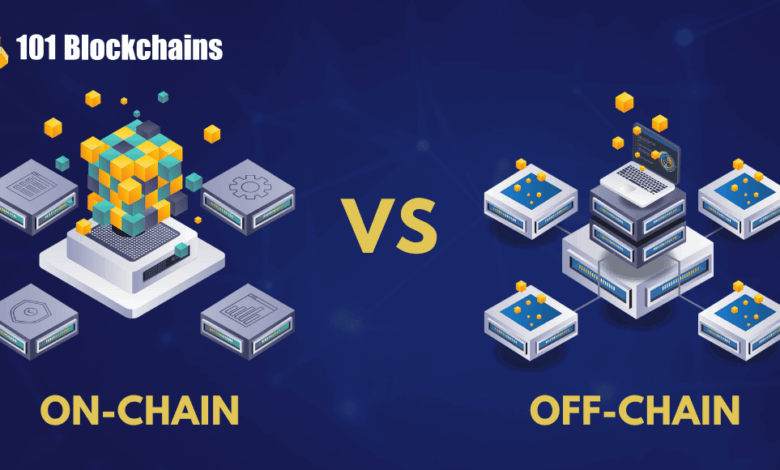On-Chain vs. Off-Chain Crypto Transactions Explained

Blockchain technology and cryptocurrencies have been garnering the top spots in news headlines for their unique advantages. With the help of blockchain, cryptocurrencies have transformed our traditional views of money and financial transactions. Do you know about the two broad categories of crypto transactions? The discussions about on-chain and off-chain transactions deserve the attention of everyone interested in blockchain technology and crypto transactions. The knowledge of differences between these two types of transactions is an essential requirement to find a way through the modern digital landscape. This post aims to discover the on-chain vs off-chain crypto transactions differences.
Build your identity as a certified blockchain expert with 101 Blockchains’ Blockchain Certifications designed to provide enhanced career prospects.
Learning the Basics of On-Chain and Off-Chain Crypto Transactions
Any beginner in the world of blockchain and cryptocurrencies would notice the benefits of security, transparency, and immutability in crypto transactions. Financial transactions on blockchain networks are completely decentralized and under the supervision of peers without any intermediaries.
With the advantages of crypto transactions on blockchain ledgers taking the limelight, the necessity of off-chain crypto transactions has become more evident. The two types of crypto transactions provide distinctive approaches to deal with some issues that come with blockchain technology.
On-chain transactions are the primary type of crypto transactions that build the secure and transparent framework of the blockchain ecosystem. On the contrary, the answers to “What is an example of an off-chain transaction?” point at the specific use cases which need more flexibility. Once you learn how both types of crypto transactions work, it will be easier for you to use them for strategic advantages.
Exploring the Fundamentals of On-Chain Transactions
As the name implies, on-chain transactions are the crypto transactions which take place on a blockchain ledger. On-chain transactions are recorded on the public, distributed ledger of the blockchain network, allowing everyone to view the transactions. You can notice how on-chain transactions boast of the advantage of unparalleled transparency.
One of the ideal ways to start the on-chain vs. off-chain transactions comparison involves understanding how on-chain transactions work. Upon initiating an on-chain transaction, the details of the transaction will be broadcasted throughout the network. The blockchain relies on consensus mechanisms to record the transaction securely on its ledger. After validating transactions and adding them to blocks, they become an immutable component of the ledger.
The best thing about on-chain crypto transactions is the assurance of trustless nature. On-chain transactions don’t depend on intermediaries thereby implying that the parties involved in a transaction don’t have to trust each other. On the contrary, on-chain transactions are significantly slower and require more resources. At the same time, you should not ignore the scalability issues associated with on-chain transactions.
Some of the prominent examples of on-chain transactions are the ones conducted on Ethereum and Bitcoin blockchain.
Excited to learn the basics of cryptocurrency and the ways in which blockchain technology empowers cryptocurrencies, Enroll now in the Cryptocurrency Fundamentals Course
Understanding the Magic of Off-Chain Transactions
The difference between on-chain and off-chain crypto transactions is clearly visible once again in the name itself. Off-chain transactions happen outside the primary blockchain network on layer-2 networks or chains that operate outside the main blockchain. The most common example of conducting off-chain crypto transactions points to payment channels that provide secure off-chain transfer of digital assets. Off-chain crypto transactions are settled outside the main blockchain and go for the final settlement on the main chain.
The notion of transferring transactions off the primary blockchain reduces the burden on the main network. It plays a major role in improving efficiency and scalability over traditional on-chain transactions. Off-chain blockchain transactions can support more transaction volume by moving transactions outside the main blockchain. On the contrary, off-chain proceedings also present the risks of emerging complexities and evolving security threats.
The most noticeable example of off-chain crypto transactions is visible on layer-2 networks such as Polygon, Lightning Network, and Optimism.
Unraveling the Differences between On-Chain and Off-Chain Crypto Transactions
The primary differences between off-chain and on-chain transactions revolve around operational mechanisms and what they mean for users. On-chain transactions are more trustworthy and secure due to direct operation on the main blockchain. At the same time, on-chain crypto transactions are slower and could become more expensive when the network is congested.
The on-chain vs. off-chain crypto transactions comparison also provides a similar painting of off-chain crypto transactions. Off-chain blockchain transactions are faster and more cost-efficient than on-chain transactions, albeit with reduced security. The following sections provide a clear description of the comparison between off-chain and on-chain transactions.
-
Relationship with Primary Blockchain
The foremost difference between on-chain and off-chain crypto transactions is visible in their relationship with the primary blockchain. On-chain crypto transactions happen on the main blockchain, where they go through validation before documentation on the ledger. The documentation of on-chain transactions ensures more security and transparency.
On the contrary, off-chain crypto transactions rely on secondary networks or layers to ensure faster transactions. Off-chain transactions happen outside the primary blockchain, thereby suggesting that they may not be documented on the main chain.
-
Level of Decentralization
You can also compare on-chain transactions with off-chain crypto transactions by noting their level of decentralization. The foremost trait of on-chain transactions is the assurance of all the advantages associated with blockchain technology. For instance, on-chain crypto transactions follow the principles of transparency, decentralization, and immutability.
On the other hand, off-chain crypto transactions can introduce some hints of centralization depending on the transaction scenario. Off-chain transaction proceedings may involve trusting the requirements of secondary layers or transaction pooling with one provider.
One of the crucial pointers for comparing on-chain transactions with their off-chain counterparts is transaction speed. On-chain transactions are slower as they require time to achieve consensus from different participants in the network. The speed of on-chain transactions takes a huge hit at the time of heavy network congestion. With multiple people trying to get their transactions through on the network, on-chain transactions may have to wait longer in queue.
The on-chain vs. off-chain transactions comparison highlights how off-chain transactions don’t depend on consensus mechanisms. Off-chain crypto transactions take away transactions from the main network and prevent network congestion alongside ensuring faster transaction settlement.
Another prominent aspect that you should consider while comparing on-chain with off-chain crypto transactions is the cost of transaction settlement. On-chain transactions impose network fees alongside the transaction charges. It is important to know that the network fees can become unreasonably higher during heavy network congestion. Therefore, you might end up spending more than the transaction itself when you attempt an on-chain crypto transaction during peak network traffic.
Off-chain crypto transactions don’t impose the burden of such liabilities as they don’t demand the costs that come with on-chain transactions.
The most valuable point for comparison between on-chain and off-chain crypto transactions is their usability. Both types of transactions share equal significance in the blockchain and crypto ecosystem with their unique applications. The on-chain vs. off-chain crypto transactions debate focuses on how the two transaction modalities cater to different user requirements. On-chain transactions are more useful for situations that need unparalleled security and immutability. On-chain transactions fit the bill perfectly for high-stakes transactions that cannot afford any risks of fraud.
Off-chain crypto transactions will be ideal for scenarios that rely on reducing costs and increasing speed while addressing scalability requirements. You can use off-chain approach in small-scale and frequent transactions such as digital payments for everyday purchases.
Final Thoughts
The comparison between off-chain and on-chain transactions gives a clear impression of their significance in the blockchain ecosystem. Awareness of the on-chain vs off-chain crypto transactions can help you identify the ideal modality for different use cases. As you learn more about each type of crypto transaction, you will discover its unique benefits and limitations. Expand your knowledge of cryptocurrency transactions and their working with the best resources now.
*Disclaimer: The article should not be taken as, and is not intended to provide any investment advice. Claims made in this article do not constitute investment advice and should not be taken as such. 101 Blockchains shall not be responsible for any loss sustained by any person who relies on this article. Do your own research!
Source link






